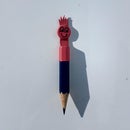Introduction: Bee & Bug Tower Hotel
This is a project to aid our garden workers - our bee's, insects, bugs and butterflies. There are lots of varieties of bug houses and this is just a different way of doing it.
Supplies
Don't spend any money on this - use what you have or go find it!
- Pallets
- Scrap wood
In this case I used the below but it depends how you wish to do it and what you have access to:
- Wire mesh
- Old clay pots
- Bamboo
- Bark
- Straw/thin sticks
- Pine Cones
You're going to need tools
Step 1: The Foundations...
You need decent wooden pallets - I was lucky as I had a couple of 'hardwood' ones and I could make 4 but in this case I'm making 3 towers.
- Chop the ends off (with the blocks)
- Clean them up
- Nail or screw them if required to make sure it all stays together.
These towers need back panels, so using scrap wood the gaps were measured and the wood cut to size, but not fitted as some of the towers would need to be filled from the rear. As most of the work would be filling the internals I decided to get the exterior painted (exterior wood paint) - this was left over from when I painted a shed.
Step 2: The Roof...
Basically pick an end and chamfer the edges. The aim is to get a surface to secure the angled roof onto. I wanted a gable end look but to make it easier you could just have the roof flat or sloping front to back.
Again scrap wood was used to create the peaked roof and this was nailed into place.
Step 3: The Rooms... Tower 1
This is the section where you can do what ever you want and make it as elaborate as you wish!
I had some hardwood found in a skip that I believe was used to cut 'plugs' from which looked interesting.
- Tower 1 top - the 'plug' panels were cut and layered in to create relatively open spaces. This was done mostly by wedging the pieces into place with the outside one being glued. Aesthetically it looked quite good as well.
- Tower 1 bottom - I made a wire cage to house pine cones. This was done by using steel bar to aid me in bending the sides to get it straight. This was secured to the inside using staples. You could just fix the wire to the front but I didn't want any sharp edges. Once the pine cones were inserted the back panel was fixed in with screws.
To finish the top off (underneath the roof) it was painted and then holes of varying sizes were drilled. Beware of the existing nails you may hit! These are for solitary bees to use. This process is to be done on each tower.
Step 4: The Rooms... Tower 2
One of the pallet ends had a steel strap running up through it which was something I wished to utilise.
- A hardwood spacer was fitted to keep the strap in place and the back wood panels were fitted.
- Bamboo was then cut to length the depth of the towering fitted one side of the strap - basically by wedging them into place.
- Thin sticks were then 'harvested' from the garden and again cut to length. These were also wedged into the other side of the strap. The aim was to produce a wave with contrasting materials.
Again the top section had more holes drilled.
Step 5: The Rooms... Tower 3
I quite liked the contrast between the painted wood and the natural hardwood, so a strip was used for the butterfly 'apartment'. On this one the back panel was fitted first.
- Tower 3 top - I used an 8mm thick strip of hardwood and cut it to fit into the tower top. I then used a router to cut 2 slots into it to create the entrance. I also cut more strips and struck them on the inside to create wind baffles and 'apartments' so butterflies and moths could find an area that suited depending on temperature and air flow.
- Tower 3 bottom - I used wire twisted together to try and create a decorative front. By drilling into the front of the tower I could then just push the wire in and hammer down. The aim of this was to house clay pot shards and the wire was to just try and keep it in place.
Step 6: Staking a Claim...
To add a little detail element I cut some hardwood strips, angled the edge slightly with a plane and glued them on as overhang strips.
Lastly 3 hardwood stakes were cut approx. 30mm square and about 1000mm long. These were screwed to the back of the towers so they could be hammered into the ground. You could also just screw them to a fence post or a wall.
Step 7: Location, Location, Location...
Initially these were designed to compliment the 'mini' shed we had by using the white paint and also to be a contrast to the border planting. They have been placed in the nearby border for photography purposes. We eventually moved them elsewhere to compliment the surrounding plant that were also tall so they were little homes in a green oasis.
( I actually moved them several times under the direction of my wife, she's the gardener... and thats the way it is).
Thanks for looking.

Participated in the
1000th Contest













